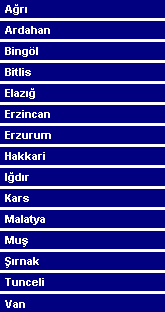| Agri... |
|
Situated in Eastern Anatolia and extending to the Iranian border, is Agri, one of the highest regions in the country with its
mountainous formation. Rising up to a height of 5,165 m, Mount Agri is the main peak of Türkiye and the symbol of the city.
This snowcapped volcano is the famous biblical Mount Ararat, the legendary site of the second beginning of the world. It is
believed that Noah's Ark rested on its summit during the big flood, and the wide plain of Igdir at the foot of the mountain
is the first place where Noah set foot after the disaster. A geological hollow near Uzengili village has the shape allegedly
of the ark, and it is a place often visited by tourists, being also a beautiful resting spot. Mount Ararat, besides offering
magnificent scenery, also provides opportunities for hunting, skiing and mountaineering. Climbing is also possible once you
get the necessary permission from the authorities. 95 km east of Agri, one of the beautiful cities of Türkiye, is the town
Dogubayazit, comprising spectacular ruins from earlier periods Ishak Pasha Palace, 6 kms outside the town center, is the
most important sight, and was constructed by the Ottoman governor, Ishak Pasha, in the 17th century. It has been
restored many since, and has become an original building of mixed architectural design. An Urartian king relief and a rock
tomb dating to the 9th century BC, are other historical remains near the palace, while ruins from the same period
are also to be found near Patnos, another important town of Agri province. An interesting place is the meteoric hole, about
80 years old, located between the Gurbulak border gate and Sancavus village. It is the second largest hole of this type in
the world with its 35 m width and 60 m depth. Besides these touristic attractions, there are other specialties of the city.
One is "Lake Balik", famous for its "trout". Still another is the local dessert "Asure", also
known as "Noah's Pudding" and it is a sweet that must be tasted. It's only 35 km between the Iranian frontier and
Dogubeyazit, a town that is dusty in summer and muddy in winter. Behind the town is a range of bare, jagged mountains,
while before it there is a table - flat expanse of wheat fields and grazing land. On the far northern side of this
flatness rises Agri Dagi, an enormous volcano capped with ice and often shrouded in dark clouds.
|
|

|


 472...
472...
 04...
04...
 528,744...
528,744...
 11,376...
11,376...
 43 E 03 - 39 N 44...
43 E 03 - 39 N 44...










